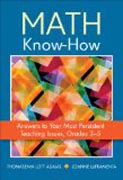
With mathematics curriculum mandates constantly evolving and expectations for student achievement on the rise, teachers are under pressure to bring math to life in the classroom and engage their students in meaningful, relevant ways. This book equips teachers with the know-how they need to make this a reality. In this teacher-friendly guide, Adams and LaFramenta demystify the Common Core State standards in mathematics and provide answers to some of the most common questions they have encountered in their years of working in the field as coaches. Chock-full of examples and vignettes, this book will empower maths teachers with the tools and knowledge they need to improve their instruction and increase their students’ understanding of key mathematical concepts. INDICE: PrefaceAcknowledgmentsAbout the Authors1. Common Core State Standards for Mathematics: Mathematics Content and Mathematical Practices Creating the Common Core State Standards for Mathematics Theoretical Basis of the Common Core State Standards for Mathematics Structure of the Common Core State Standards for Mathematics Two Brief Notes Summary Questions and Tasks for Reflection2. Making Mathematics Teaching Decisions Learning: The Primary Purpose of School and the Primary Goal of Teaching The Nature of Learning Formative Assessment: Discovering the Prior Knowledge Types of Formative Assessment Practices Making the Decisions of Teaching Summary Questions and Tasks for Reflection3. Using the Pacing Guide Effectively Pacing Guides for Mathematics Instruction Role of the Mathematics Pacing Guide How Do Mathematics Standards Influence the Pacing Guide? Pacing and Mastery Summary Questions and Tasks for Reflection4. Approach to Planning Mathematics Instruction Perspective: Mathematics Content Perspective: Models of Instruction 4-A Way to Mathematical Success Overarching Instructional Strategies Summary Questions and Tasks for Reflection5. Facilitating Differentiated Instruction Introduction to Differentiated Instruction Specific Points About Differentiated Instruction Summary Questions and Tasks for Reflection6. Teaching and Learning Mathematics With Manipulatives Young Students Learn Best When Mathematics Is Linked to a Real-World Context Selection of Manipulatives Use of Manipulatives Tools in the Practice Standards Summary Questions and Tasks for Reflection7. Appropriate Use of Technology Technology in the Classrooms Technology for the Learner Effective Implementation in the Classroom Evaluating the Use of the Technology Technology for the Teacher Summary Questions and Tasks for Reflection8. Reflecting on the Teaching Practice of Mathematics What Is Reflection on Teaching? Connecting Anticipations and Results Measuring the Outcomes The Formal Reflection Process Summary Questions and Tasks for Reflection9. Understanding the Learner The Expectations From the Common Core State Standards Initiative (CCSSI) The Special Case of Gloria Jean Merriex Culturally Responsive Teaching Summary Questions and Tasks for Reflection10. Mathematics Assessment 101 Introduction Summative Assessment Authentic Assessment Summary Questions and Tasks for Reflection11. Conclusion All Eyes on Mathematics EducationAppendix: Resources for TeachersReferencesIndex
- ISBN: 978-1-4522-8263-3
- Editorial: Corwin
- Encuadernacion: Rústica
- Páginas: 208
- Fecha Publicación: 28/02/2014
- Nº Volúmenes: 1
- Idioma:
